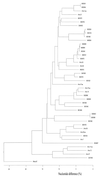Improved detection of rhinoviruses in clinical samples by using a newly developed nested reverse transcription-PCR assay
- PMID: 9986806
- PMCID: PMC84449
- DOI: 10.1128/JCM.37.3.524-530.1999
Improved detection of rhinoviruses in clinical samples by using a newly developed nested reverse transcription-PCR assay
Abstract
This paper describes the development and evaluation of a new nested reverse transcription (RT)-PCR for the detection of rhinovirus in clinical samples. The nucleotide sequences of the 5' noncoding regions of 39 rhinoviruses were determined in order to map the most conserved subregions. We designed a set of rhinovirus-specific primers and probes directed to these subregions and developed a new nested RT-PCR. The new assay includes an optimal RNA extraction method and amplicon identification with probe hybridization to discriminate between rhinoviruses and the closely related enteroviruses. It proved to be highly sensitive and specific. When tested on a dilution series of cultured viruses, the new PCR protocol scored positive at 10- to 100-fold-higher dilutions than a previously used nested RT-PCR. When tested on a collection of clinical samples obtained from 1,070 acute respiratory disease patients who had consulted their general practitioners, the new assay demonstrated a rhinovirus in 24% of the specimens, including all culture-positive samples, whereas the previously used PCR assay or virus culture detected a rhinovirus in only 3.5 to 6% of the samples. This new assay should help determine the disease burden associated with rhinovirus infections.
Figures


References
-
- Arruda E, Hayden F G. Detection of human rhinovirus RNA in nasal washings by PCR. Mol Cell Probes. 1993;7:373–379. - PubMed
Publication types
MeSH terms
Substances
Associated data
- Actions
- Actions
- Actions
- Actions
- Actions
- Actions
- Actions
- Actions
- Actions
- Actions
- Actions
- Actions
- Actions
- Actions
- Actions
- Actions
- Actions
- Actions
- Actions
- Actions
- Actions
- Actions
- Actions
- Actions
- Actions
- Actions
- Actions
- Actions
- Actions
- Actions
LinkOut - more resources
Full Text Sources
Other Literature Sources

